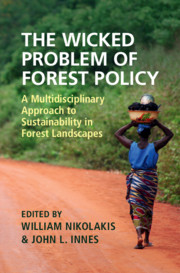 The Wicked Problem of Forest Policy
The Wicked Problem of Forest Policy Part I - Wicked Problems and Policies
Published online by Cambridge University Press: 24 July 2020
Summary

- Type
- Chapter
- Information
- The Wicked Problem of Forest PolicyA Multidisciplinary Approach to Sustainability in Forest Landscapes, pp. 31 - 258Publisher: Cambridge University PressPrint publication year: 2020
